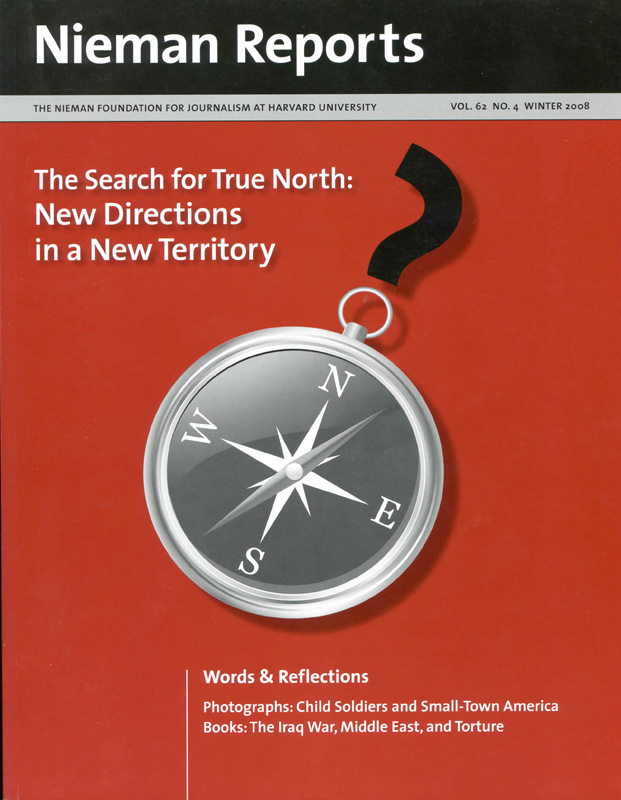Just a couple of years ago, despite the clear digital direction of news consumption, it was still pretty hard to engage in a serious discussion of business model change in most news media companies. Sure, the world was in transition, but there was still time to adapt, or so it seemed.
That time is now officially, and undeniably, up.
All of the trends that news providers have been analyzing since the dawn of the decade are now in full swing. Consumption of news is generally occurring first on digital platforms, and most of the audience is connecting intermittently through multiple points of entry rather than making regular appointments with traditional news packages such as newspapers, broadcasts or bookmarked news Web sites.
But many media companies remain in a state of reluctant transformation, stuck between the demands of the old and new worlds, mainly because the business model for news distribution has not evolved as fast as consumption has shifted.
Companies are still relying on their edited packages to drive their businesses, and they really have no other choice. Even as revenues decline, the packages still manage to deliver more revenue, if not audience, than unproven alternatives that allow content components—stories, photos, video clips—to float freely through the channels of search, widgets and mobile applications.
The fledgling revenue models supporting the new distribution of digitized content are not yet strong enough to fund the newsgathering the old models nurtured and expanded through the 20th century. The dollars for subscription and advertising revenue are different in the new digital world of the 21st century—and lower by an order of magnitude.
The critical question facing the business is whether we can innovate our way through this rough transition in the business model. Can we carry innovation beyond content and technology to the less familiar territory of reimagining the business itself?
Every news company is grappling with a version of the same problem. For newspapers, it’s a question of rightsizing to something smaller, or committing to a digital shift that portends big changes in news coverage, packaging and distribution across print and digital channels. For broadcasters, it’s all about expanding into new channels without expanding the heavy costs of video newsgathering and production. Even native digital companies face the challenge of figuring out how to distribute content profitably beyond the boundaries of their destination Web sites.
For a news agency like the AP, which serves other media companies, the challenge is to imagine a new model that enables its clients to succeed across platforms without creating new conflicts among competing publishers, broadcasters and digital distributors. And it must be done at a lower cost to those clients because overall revenue for the news business is compressing.
Consuming the News
There are no easy answers to any of these questions, and a weak economy compounds the difficulty. But at AP we continue to focus on the fundamental change in news consumption patterns and what that means for both content creation and distribution. In the past year, with the help of a team of professional anthropologists, we studied the behavior of young-adult news consumers in six cities around the world and drew important conclusions about how to reconstruct our news model to fit the new cultural reality of cross-platform, opportunistic consumption of news.
Strip away the research jargon, and what that means is that young people around the world today are more likely to connect to the latest news through e-mail, search or text messaging than through old media channels.
Of course, that was something we very much expected to see. But through the intense interview process that distinguishes anthropology from simple surveying, we also heard something from the subjects we didn’t expect to learn: They were mostly unsatisfied with their news experiences.
Despite the convenience of always-on access, the subjects said they were overdosing on short snippets of facts and updates and longed to explore the news in more breadth and depth. They wanted more of the back and future stories associated with the daily stream of headline-driven news. And that was the case across geography—cities in the United States, Britain and India—and across news category. No matter if the topic was war, natural disaster or entertainment, the consumers in our study wanted to know more, and they seemed willing to go get it, if only they knew where to find it.
Whether or not the journalism market is actually shorting breadth and depth in favor of breaking news is a question that could spark a spirited debate in any newsroom around the world, but the essential point should not be missed. That is, whether or not we’re producing it, people aren’t readily finding it in the opportunistic patterns of consumption they’ve adopted.
In today’s news environment, technology unwraps the tidy packages that news providers produce. News gets split apart into atomic pieces for today’s digital consumption—headlines, 25-word summaries, stand-alone photos, podcasts and video clips—all of which can be easily e-mailed, searched and shared outside of their original packaging.
Refitting the News
The model that emerged from our anthropology study helped to frame the task ahead by splitting the news into its fundamental “atomic” pieces of Facts, Updates, Back Story, and Future Story. That sets up a mission to create and connect the essential parts of a next-generation news report, much as the old “inverted pyramid” established a framework for newspaper writing.
The inverted pyramid conditioned writers to organize the information in their stories from most important to least important. It drove the journalism and the business of the AP news cooperative for more than a century and a half, as the news was packaged day in and day out for space-efficient display in newspapers.
The model even worked for new media as they came along through the decades. AP created services based on newspaper stories to supply news for radio, television and eventually the Internet and mobile platforms. But newspaper stories, packaged as a snapshot in time, struggle to connect with an audience that is being conditioned to aggregate and manipulate unpackaged information on their own.
For AP, these trends delivered a clear directive to adjust the newspaper-story-first mentality. A shift to fastest-formats-first had already been made at the agency well before our consumer study. That shift has now accelerated with key new initiatives to enhance the differentiation of services to match platform and market needs.
Chief among those initiatives is a fundamental new process for newsgathering in the field called “1-2-3 filing.” The name describes a new editorial workflow that requires the first words of a text story to be delivered in a structured alert (headline format) to be followed by a short, present-tense story delivering the vital details in step two. Then, in a final step, a story takes whatever form is appropriate for different platforms and audiences—a longer form story or analysis for print, for example. Other media types are coordinated along the way in similar fashion.
Another major initiative at AP responds to the need for more variety in the news. Major new content development projects have been launched in entertainment, sports and financial news to create more entry points for consumers with appetites for broader, deeper content in those categories.
Across the gamut of AP’s reporting, we are pursuing stories with impact and writing in a lively and authoritative style that has both raised our profile and caused some traditionalists to wonder where the old wire service went. Despite the stir in some journalism circles, there’s no reason to mourn the loss of stodginess, real or perceived. AP’s origins may trace back to transcribing the shipping news, but its future lies in engaging the audience with more than just the facts, as our new model suggests.
Content initiatives alone, however, can’t get the job done. Digitally based consumption by a fragmented audience requires new and sophisticated distribution mechanics, meaning an infrastructure that can smartly connect consumers to available, relevant content in virtually unlimited ways. The key to making that happen is to make content more linkable and discoverable. For that, you need a system for tagging news content with codes for categories and names (famous people, places and things) that computers can easily read to deliver content at a user’s command.
The AP has created such a system and is using it to power a comprehensive news service, called the Mobile News Network, for the Apple iPhone and other smartphones. In the future, we hope the AP “metadata” tags will help surface more relevant and timely news content through search engines.
Still to come, to complete the business model shift, are the revenue streams that will drive the new distribution of smart content. For the Mobile News Network, national and local advertising is being pursued to support display of headlines, stories, images and video clips on the phones. Constituent newspaper members of the AP are joining the network to build the scope and scale that new digital businesses will require to succeed.
As Google’s advertising model has proven so definitively, a business built on clicks requires a network of massive numbers, not just a single Web site. While the old packaged media models may have enjoyed bigger returns on smaller bases, they dealt in scarcity, not ubiquity.
When information is available any time, any place, as it will be for generations of news consumers to come, models must be constructed to connect huge numbers of people with personalized bits of information. Those models will be driven by the aggregation of content, advertising and audience on a very large scale—perhaps not all in one place, but virtually all connected.
Jim Kennedy is the vice president and director of strategic planning for The Associated Press.



